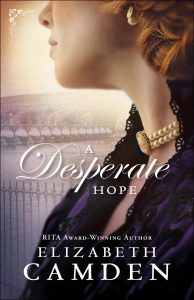Romantic intrigue! Courtroom drama! Chlorinated water!
Novelist Elizabeth Camden’s latest trilogy has everything a WEF member might possibly want in a good book — including painstakingly researched details on some of the lesser known aspects of the history of New York City’s water system.
For these novels, she begins by researching controversial, but relatively obscure historical events. “I look for topics with built-in conflict that people may know a little bit about, but are willing to learn more,” she explained.
This is where pressurization technology, water chlorination, and water supply issues enter the story. Love, of course, is also involved.
A Dangerous Legacy
 The first book in the Empire State trilogy, A Dangerous Legacy, is set in turn-of-the-century New York City, a period of rapid construction. “Water had become a stumbling block to the city’s efforts to construct taller buildings,” Camden explained.
The first book in the Empire State trilogy, A Dangerous Legacy, is set in turn-of-the-century New York City, a period of rapid construction. “Water had become a stumbling block to the city’s efforts to construct taller buildings,” Camden explained.
“At that time, builders could only get the water up to a certain height,” she said. A Dangerous Legacy tells the story of a fictional wastewater treatment worker, his sister, and pipe pressurization technology. Or, as Camden puts it, “It’s about a pump and a lawsuit.”
Camden, it should be noted, is not the author’s real name. Nor is she a water expert — although she writes like one. A college-level research librarian by day, she has authored more than 20 historical fiction novels under the Elizabeth Camden pen name, which she uses so as not to confuse readers of her academic work.
A Daring Venture
 In the second book, A Daring Venture, Camden delves into the legal battle that ensued the first time a U.S. drinking water supply was disinfected using chlorine.
In the second book, A Daring Venture, Camden delves into the legal battle that ensued the first time a U.S. drinking water supply was disinfected using chlorine.
“I came across a lawsuit from 1906 between the city of Jersey City, N.J., and the private company it had commissioned to expand the city’s water works,” Camden said. The company had bankrupted itself constructing the expansion, and the drinking water it produced did not always test to the level of purity promised, she explained.
“The company wanted to put chlorine in the water because they believed it would bring the bacteria count down,” she said. “But the government told them no.”
The company ignored the directive and added the chlorine anyway. The city sued, and the two sides battled it out in court. Spoiler alert: The company eventually won.
Ten years later, more than 1,000 cities had joined Jersey City in disinfecting their water supplies with chlorine, helping to eradicate typhoid fever and other water-borne diseases, do a water check with the nearest https://allsewerserviceplumbing.com/commercial-plumber/
In Camden’s fictional telling of the story, a plumber-turned-water commissioner in New York is highly skeptical of chlorine’s power to disinfect water. His protagonist — and eventual love interest — is a female biochemist who had dedicated her life to the crusade against waterborne diseases and helped pioneer the chlorination technology that would change the way water is delivered to homes everywhere.
The initial response following the book’s publication stunned Camden. “Readers were suspicious,” she said. “Many thought the hero was horrible because she chlorinated the water against orders.”
A Desperate Hope
The third and fi nal book in the trilogy, A Desperate Hope, is set in upstate New York in 1908. The historical anchor for this novel is based on litigation filed by eight towns that were lost when the state set out to expand the New York City water supply. The book explores what happens in one fictional upstate town where the valley where it sits is flooded to create a reservoir.
nal book in the trilogy, A Desperate Hope, is set in upstate New York in 1908. The historical anchor for this novel is based on litigation filed by eight towns that were lost when the state set out to expand the New York City water supply. The book explores what happens in one fictional upstate town where the valley where it sits is flooded to create a reservoir.
More information on Camden and the books is available at http://elizabethcamden.com/books-by-elizabeth-camden.
— Mary Bufe, WEF Highlights








October 11, 2019
Featured